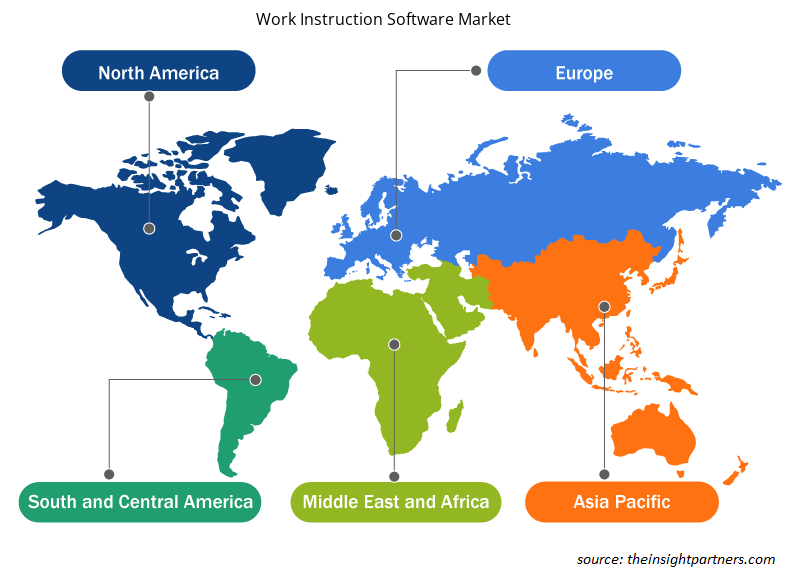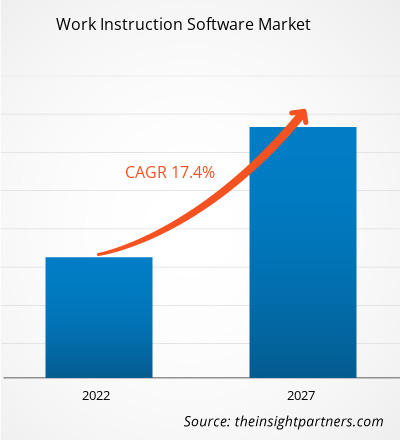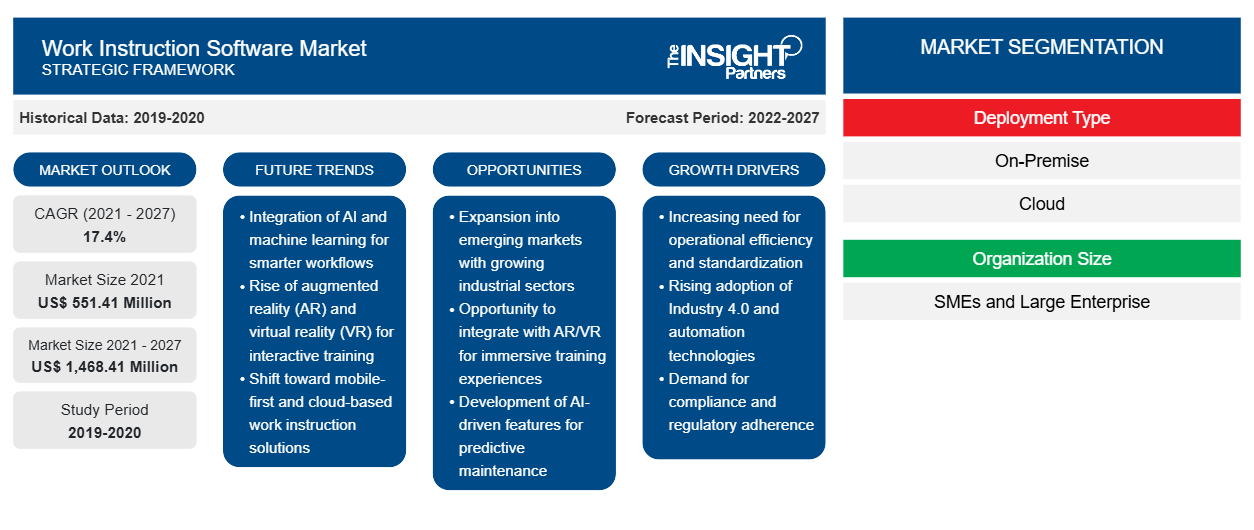工作指令软件市场预计将从 2021 年的 5.5141 亿美元增长到 2027 年的 14.6841 亿美元。预计在 2020 年至 2027 年的预测期内,工作指令软件市场将以 17.4% 的复合年增长率增长。
推动市场发展的关键因素是不断变化的业务和生产复杂性。采用混合模式生产流程来提高整个组织的制造生产力,需要加强员工的培训和发展。因此,这推动了整个制造业采用工作指导软件。员工培训以提高生产力的需求导致整个企业采用技术先进的解决方案。制造业、汽车业、医疗保健业和零售业等行业的工作流程越来越复杂,这增加了员工和劳动者对工作指导的需求,以便他们独立高效地完成任务。例如,Augmentir, Inc. 提供人工智能驱动的互联劳动力平台,帮助员工在整个工作过程中实现数字化工作流程和远程指导。
随着 COVID-19 疫情在全球蔓延,很少有企业能够逃脱其影响,这给所有行业带来了重大挑战。然而,该软件的主要应用领域是制造业,该软件用于向员工提供有关某些机器运作的培训。因此,发达国家和发展中国家所有制造部门的关闭预计将对工作指令软件市场的增长产生负面影响。
根据部署类型,工作指导软件分为本地和云。预计在预测期内,基于云的解决方案将以最高的复合年增长率增长。此外,根据组织规模,工作指导软件市场分为中小型企业和大型企业。大型企业占据了市场的大部分份额。全球工作指导软件市场分为五个主要地区——北美、欧洲、亚太地区、中东和非洲以及南美地区。
定制此报告以满足您的需求
您可以免费定制任何报告,包括本报告的部分内容、国家级分析、Excel 数据包,以及为初创企业和大学提供优惠和折扣
-
获取此报告的关键市场趋势。这个免费样品将包括数据分析,从市场趋势到估计和预测。
工作指令软件市场洞察
改变整个组织的工作文化
自带设备 (BYOD) 的兴起,加上各组织(尤其是大型企业)的远程工作文化,催生了对工作指导解决方案的需求,以确保组织平稳运作。组织中灵活的工作文化导致员工无法在办公室工作,这会打乱工作流程,尤其是对于初级员工而言,他们需要持续的帮助来学习和执行工作以实现目标。因此,跨组织整合工作指导解决方案使雇主能够指导所有员工,而不会让物理障碍影响生产效率。
基于部署类型的市场洞察
根据部署类型,全球工作指令软件市场分为基于云和本地部署。与本地工作指令软件相比,基于云的工作指令软件的需求量很大。由于云的成本相对较低,且发达国家拥有强大的网络基础设施,因此云部分产生了大部分需求。此外,基于云的工作指令软件供应商高度专注于开发高级安全补丁,以消除网络攻击的风险。这一因素也产生了来自最终用户的巨大需求,从而推动了工作指令软件市场的发展。
基于组织规模的市场洞察
根据组织规模,工作指导软件市场分为中小型企业和大型企业。发达国家和发展中国家对制造业基础设施的投资不断增加,极大地推动了中小企业对工作指导软件的需求。
工作指令软件市场中的参与者专注于市场计划、收购和产品发布等策略,以保持其在工作指令软件市场中的地位。工作指令软件市场主要参与者的一些发展如下:
2020 年 4 月,SwipeGuide 与 XMReality 合作,利用远程支持部署数字工作说明。
2019 年 10 月,Georg Fischer Signet 实施了 Lifecycle Technology Ltd 的 AssemblyX 用于工作仪表。
工作指令软件市场区域洞察
Insight Partners 的分析师已详细解释了预测期内影响工作指令软件市场的区域趋势和因素。本节还讨论了北美、欧洲、亚太地区、中东和非洲以及南美和中美洲的工作指令软件市场细分和地理位置。

- 获取工作指导软件市场的区域特定数据
工作指令软件市场报告范围
| 报告属性 | 细节 |
|---|---|
| 2021 年市场规模 | 5.5141亿美元 |
| 2027 年市场规模 | 14.6841亿美元 |
| 全球复合年增长率(2021 - 2027 年) | 17.4% |
| 史料 | 2019-2020 |
| 预测期 | 2022-2027 |
| 涵盖的领域 |
按部署类型
|
| 覆盖地区和国家 |
北美
|
| 市场领导者和主要公司简介 |
|
工作指令软件市场参与者密度:了解其对业务动态的影响
工作指令软件市场正在快速增长,这得益于最终用户需求的不断增长,这些需求源于消费者偏好的不断变化、技术进步以及对产品优势的认识不断提高等因素。随着需求的增加,企业正在扩大其产品范围,进行创新以满足消费者需求,并利用新兴趋势,从而进一步推动市场增长。
市场参与者密度是指在特定市场或行业内运营的企业或公司的分布情况。它表明在给定市场空间中,相对于其规模或总市场价值,有多少竞争对手(市场参与者)存在。
在工作指令软件市场运营的主要公司有:
- 生命周期科技有限公司
- Livepro 知识管理
- 滑动指南
- ScreenSteps有限责任公司
- 视觉知识共享有限公司
免责声明:上面列出的公司没有按照任何特定顺序排列。

- 获取工作指令软件市场顶级关键参与者概览
工作指令软件市场 – 按部署类型
- 云
- 本地部署
工作指令软件市场 – 按组织规模
- 大型企业
- 中小企业
工作指令软件市场 – 按地区划分
-
北美
- 我们
- 加拿大
- 墨西哥
-
欧洲
- 法国
- 德国
- 俄罗斯
- 英国
- 意大利
- 欧洲其他地区
-
亚太地区 (APAC)
- 中国
- 印度
- 日本
- 澳大利亚
- 韩国
- 亚太地区其他地区
-
中东及非洲
- 沙特阿拉伯
- 阿联酋
- 南非
- MEA 其他地区
-
山姆
- 巴西
- 阿根廷
- SAM 其余部分
工作指令软件市场 – 公司简介
- 土月
- eFlex 系统
- 六角形AB
- 生命周期科技有限公司
- Livepro 知识管理
- 奥普泰软件
- ScreenSteps有限责任公司
- 滑动指南
- 视觉知识共享有限公司
- 扎普蒂克
- 历史分析(2 年)、基准年、预测(7 年)及复合年增长率
- PEST和SWOT分析
- 市场规模、价值/数量 - 全球、区域、国家
- 行业和竞争格局
- Excel 数据集
客户评价
购买理由
- 明智的决策
- 了解市场动态
- 竞争分析
- 客户洞察
- 市场预测
- 风险规避
- 战略规划
- 投资论证
- 识别新兴市场
- 优化营销策略
- 提升运营效率
- 顺应监管趋势























 获取免费样品 - 工作指导软件市场
获取免费样品 - 工作指导软件市场